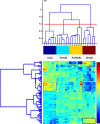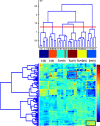Maize proteomic responses to separate or overlapping soil drought and two-spotted spider mite stresses
- PMID: 27334025
- PMCID: PMC5018026
- DOI: 10.1007/s00425-016-2559-6
Maize proteomic responses to separate or overlapping soil drought and two-spotted spider mite stresses
Abstract
In maize, leaf proteome responses evoked by soil drought applied separately differ from those evoked by mite feeding or both types of stresses occurring simultaneously. This study focuses on the involvement of proteomic changes in defence responses of a conventional maize cultivar (Bosman) to the two-spotted spider mite infestation, soil drought and both stresses coexisting for 6 days. Under watering cessation or mite feeding applied separately, the protein carbonylation was not directly linked to the antioxidant enzymes' activities. Protein carbonylation increased at higher and lower SOD, APX, GR, POX, PPO activities following soil drought and mite feeding, respectively. Combination of these stresses resulted in protein carbonylation decrease despite the increased activity of all antioxidant enzymes (except the CAT). However, maize protein network modification remains unknown upon biotic/abiotic stresses overlapping. Here, using multivariate chemometric methods, 94 leaf protein spots (out of 358 considered; 2-DE) were identified (LC-MS/MS) as differentiating the studied treatments. Only 43 of them had individual discrimination power. The soil drought increased abundance of leaf proteins related mainly to photosynthesis, carbohydrate metabolism, defence (molecular chaperons) and protection. On the contrary, mite feeding decreased the abundance of photosynthesis related proteins and enhanced the abundance of proteins protecting the mite-infested leaf against photoinhibition. The drought and mites occurring simultaneously increased abundance of proteins that may improve the efficiency of carbon fixation, as well as carbohydrate and amino acid metabolism. Furthermore, increased abundance of the Rubisco large subunit-binding protein (subunit β), fructose-bisphosphate aldolase and mitochondrial precursor of Mn-SOD and decreased abundance of the glycolysis-related enzymes in the mite-free leaf (in the vicinity of mite-infested leaf) illustrate the involvement of these proteins in systemic maize response to mite feeding.
Keywords: Antioxidants; Simultaneous stresses; Stress-related proteins; Tetranychus urticae; Water deficiency; Zea.
Conflict of interest statement
The authors declare that they have no conflict of interest.
Figures










Similar articles
-
Comparative analysis of proteome changes induced by the two spotted spider mite Tetranychus urticae and methyl jasmonate in citrus leaves.J Plant Physiol. 2011 Mar 1;168(4):392-402. doi: 10.1016/j.jplph.2010.07.026. J Plant Physiol. 2011. PMID: 20926159
-
Plant Bio-Wars: Maize Protein Networks Reveal Tissue-Specific Defense Strategies in Response to a Root Herbivore.J Chem Ecol. 2018 Aug;44(7-8):727-745. doi: 10.1007/s10886-018-0972-y. Epub 2018 Jun 21. J Chem Ecol. 2018. PMID: 29926336
-
Spatial response of Medicago truncatula plants to drought and spider mite attack.Plant Physiol Biochem. 2018 Sep;130:658-662. doi: 10.1016/j.plaphy.2018.08.018. Epub 2018 Aug 13. Plant Physiol Biochem. 2018. PMID: 30139552
-
Understanding the responses of rice to environmental stress using proteomics.J Proteome Res. 2013 Nov 1;12(11):4652-69. doi: 10.1021/pr400689j. Epub 2013 Sep 17. J Proteome Res. 2013. PMID: 23984864 Review.
-
Proteomics and phosphoproteomics reveal the different drought-responsive mechanisms of priming with (Z)-3-hexenyl acetate in two tea cultivars.J Proteomics. 2023 Oct 30;289:105010. doi: 10.1016/j.jprot.2023.105010. Epub 2023 Oct 4. J Proteomics. 2023. PMID: 37797878 Review.
Cited by
-
Plant Defense Responses to Biotic Stress and Its Interplay With Fluctuating Dark/Light Conditions.Front Plant Sci. 2021 Mar 4;12:631810. doi: 10.3389/fpls.2021.631810. eCollection 2021. Front Plant Sci. 2021. PMID: 33763093 Free PMC article. Review.
-
Aphid-Triggered Changes in Oxidative Damage Markers of Nucleic Acids, Proteins, and Lipids in Maize (Zea mays L.) Seedlings.Int J Mol Sci. 2019 Jul 31;20(15):3742. doi: 10.3390/ijms20153742. Int J Mol Sci. 2019. PMID: 31370193 Free PMC article.
-
Nitric Oxide in Plant Functioning: Metabolism, Signaling, and Responses to Infestation with Ecdysozoa Parasites.Biology (Basel). 2023 Jun 28;12(7):927. doi: 10.3390/biology12070927. Biology (Basel). 2023. PMID: 37508359 Free PMC article. Review.
-
Abscisic Acid Insensitive 4 transcription factor is an important player in the response of Arabidopsis thaliana to two-spotted spider mite (Tetranychus urticae) feeding.Exp Appl Acarol. 2017 Dec;73(3-4):317-326. doi: 10.1007/s10493-017-0203-1. Epub 2017 Dec 5. Exp Appl Acarol. 2017. PMID: 29210003 Free PMC article.
-
Integrating ecophysiology and omics to unlock crop response to drought and herbivory stress.Front Plant Sci. 2024 Nov 4;15:1500773. doi: 10.3389/fpls.2024.1500773. eCollection 2024. Front Plant Sci. 2024. PMID: 39559770 Free PMC article. No abstract available.
References
-
- Barrs HD. Determination of water deficits in plant tissue. In: Kozlowski TT, editor. Water deficits and plant growth. New York: Academic Press; 1968. pp. 235–368.
-
- Beers RF, Sizer IW. A spectrophotometric method for measuring the breakdown of hydrogen peroxide by catalase. J Biol Chem. 1952;195:133–140. - PubMed
MeSH terms
Substances
LinkOut - more resources
Full Text Sources
Other Literature Sources
Miscellaneous

